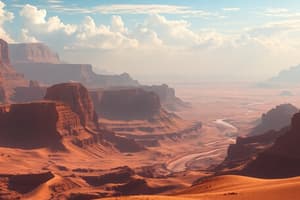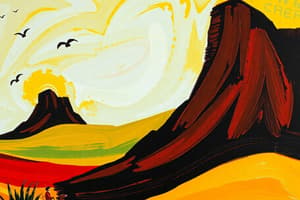Podcast
Questions and Answers
What are some of the minerals found in the Sahara desert?
What are some of the minerals found in the Sahara desert?
- Platinum and copper
- Gold and silver
- Diamonds and emeralds
- Iron, phosphorus, and uranium (correct)
Which animals do the nomadic tribes in the Sahara desert rear for various purposes?
Which animals do the nomadic tribes in the Sahara desert rear for various purposes?
- Lions and tigers
- Goats, sheep, camels, and horses (correct)
- Cows and pigs
- Elephants and zebras
What type of landscape change is occurring in the Sahara desert due to modernization?
What type of landscape change is occurring in the Sahara desert due to modernization?
- Planting more date palms
- Increasing the number of nomadic tribes
- Addition of more oases
- Construction of skyscrapers and highways (correct)
What cash crop is famous worldwide and grown in Egypt?
What cash crop is famous worldwide and grown in Egypt?
What is transforming the Sahara desert according to the text?
What is transforming the Sahara desert according to the text?
What activity are more and more nomadic herdsmen in the Sahara desert taking up?
What activity are more and more nomadic herdsmen in the Sahara desert taking up?
Which of the following best describes the Sahara desert?
Which of the following best describes the Sahara desert?
How many countries does the Sahara desert touch?
How many countries does the Sahara desert touch?
Which is the correct statement about the size of the Sahara desert?
Which is the correct statement about the size of the Sahara desert?
What type of deserts can be found based on the temperatures in the Sahara?
What type of deserts can be found based on the temperatures in the Sahara?
Which continent is the Sahara desert located in?
Which continent is the Sahara desert located in?
What feature immediately comes to mind when thinking of a desert?
What feature immediately comes to mind when thinking of a desert?
What type of vegetation can be found in the Sahara desert?
What type of vegetation can be found in the Sahara desert?
What animals were commonly found in the Sahara when it used to be a lush green plain?
What animals were commonly found in the Sahara when it used to be a lush green plain?
What was the recorded highest temperature in Al Azizia in the Sahara desert?
What was the recorded highest temperature in Al Azizia in the Sahara desert?
What change in climate transformed the Sahara desert into a hot and dry region?
What change in climate transformed the Sahara desert into a hot and dry region?
What are some of the prominent animal species found in the Sahara desert today?
What are some of the prominent animal species found in the Sahara desert today?
What geographical features are present besides sands in the Sahara desert?
What geographical features are present besides sands in the Sahara desert?
Flashcards are hidden until you start studying
Study Notes
The Sahara Desert
- The Sahara Desert covers a vast area of 8.54 million sq.km, spanning across 11 countries in North Africa, including Algeria, Chad, Egypt, Libya, Mali, Mauritania, Morocco, Niger, Sudan, Tunisia, and Western Sahara.
- The desert is characterized by extremely high temperatures, scarce vegetation, and low rainfall.
Geography
- The Sahara Desert is not just composed of sand, but also features gravel plains and elevated plateaus with bare rocky surfaces that can be over 2500m high in some areas.
Climate Change
- The Sahara Desert was once a lush green plain, with rivers and a diverse array of wildlife, including crocodiles, elephants, lions, giraffes, and ostriches.
- A change in climate has transformed the region into a hot and dry environment.
Climate
- The Sahara Desert has a scorching hot and dry climate, with short rainy seasons and cloudless skies.
- Temperatures can soar up to 50°C during the day and drop to near zero degrees at night.
Flora and Fauna
- Vegetation in the Sahara Desert is limited, with cactus, date palms, and acacia trees being some of the few species that can survive.
- The desert is home to a range of animal species, including camels, hyenas, jackals, foxes, scorpions, and snakes.
- Fossil evidence has revealed that fish once inhabited the area, suggesting a drastically different environment in the past.
Human Settlement
- Despite the harsh climate, the Sahara Desert has been inhabited by various groups of people, including the Bedouins and Tuaregs.
- These nomadic tribes rear livestock such as goats, sheep, camels, and horses, which provide them with essential resources like milk, hides, and hair.
- Oasis settlements, like those found in the Sahara and the Nile Valley, support a more settled population, with crops like dates, rice, wheat, barley, and beans being grown.
- The discovery of oil and other minerals like iron, phosphorus, manganese, and uranium is transforming the Sahara Desert and its cultural landscape.
Studying That Suits You
Use AI to generate personalized quizzes and flashcards to suit your learning preferences.




